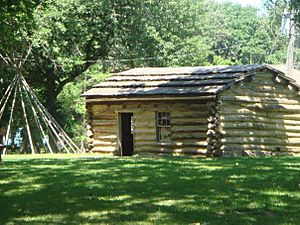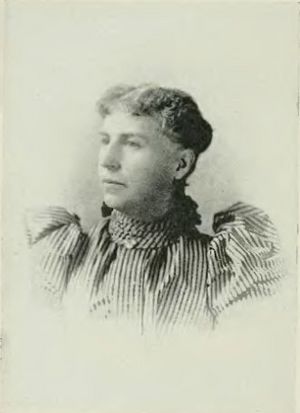Spirit Lake Massacre facts for kids
The Spirit Lake Attack happened between March 8 and 12, 1857. It was an attack by a group of Santee Sioux people called the Wahpekute. They attacked small settlements in Iowa during a very cold winter.
A leader named Inkpaduta (which means Scarlet Point) led about 14 Sioux warriors. They were very hungry because there was not enough food. They attacked the settlements near Okoboji and Spirit lakes in northwestern Iowa, close to the Minnesota border. Inkpaduta wanted revenge because a man named Henry Lott had killed his brother and his family.
The Sioux killed about 35 to 40 settlers in their homes. They also took four young women as captives, meaning they were held against their will. Then, they headed north. The youngest captive, Abbie Gardner, was held for a few months. She was later set free after a payment was made. This was the last attack by Native Americans on settlers in Iowa. However, it made things more difficult between the Sioux and settlers in the Minnesota Territory.
Almost 30 years later, in 1885, Abbie Gardner-Sharp wrote a book about her experience. It was called History of the Spirit Lake Massacre and Captivity of Miss Abbie Gardner. This book was printed many times. It was one of the last stories written by European Americans who had been held captive by Native Americans. In 1891, Gardner-Sharp bought her old family cabin. She lived there for the rest of her life, earning money from her book and souvenirs. A monument was built in the town to remember the attack. Today, the State of Iowa takes care of the park and Abbie Gardner Sharp's home.
Contents
Why the Attack Happened
Inkpaduta led a small group of Wahpekutes. They had left their main group after a leader was killed in 1840. This group, which included women and children, lived by hunting. But there was less game to hunt because more settlers were moving into the area.
The Sioux had also signed agreements with the United States government in 1852. These agreements promised them payments and land. However, the government often did not send the full amount of money or supplies they promised. They also did not make improvements to the land set aside for the Sioux. This meant the Sioux often did not have enough food or resources to survive. Many Sioux had to live off the reservations to find food, especially in winter. When they met new settlers, problems often started.
During the very harsh winter of 1856–1857, there was a lot of snow. Inkpaduta and his group were very hungry. They asked for food from the settlers in northwestern Iowa. The settlers were also struggling that winter and sometimes refused to help. In one case, a group of settlers took away the weapons of Inkpaduta's group after they killed a settler's dog. The Sioux managed to get more weapons. Then, they attacked the settlements in revenge.
Another story says that the group was camped near what is now Smithland, Iowa. Native people were sometimes treated badly for taking food or grain from fields. A group of settlers from Smithland went to their camp. They took the Indians' guns and said they would return. The Indians left their camp that night.
The Attack and Captives
The hungry and defenseless group moved north. The first attack of the Spirit Lake Massacre may have happened at Lost Island Lake, near Ruthven, Iowa. A warrior looking for food and guns was shot near a cabin. As the group continued their journey, they killed about 35 to 40 settlers. They did not spare anyone, no matter their age or gender.
The Sioux took four young women as captives. One was 14-year-old Abbie Gardner. The other three were married women. The group then headed back to Minnesota Territory. News of the attacks spread quickly. The U.S. government official for Native American affairs organized a group of armed citizens. Because of the heavy snow, help from Fort Dodge, Iowa, could not arrive in time. Another group from Fort Ridgely in Minnesota tried to catch Inkpaduta's group but failed. Abbie Gardner later wrote that the soldiers were very close to them but did not know it.
Settlers wanted revenge, but government officials decided not to act until the captives were returned. Some settlers wrongly killed innocent Sioux who were hunting nearby. When officials finally contacted Inkpaduta's group, they learned that two of the captive women had been killed. In May, the government offered a payment for the captives. Soon after, two Wahpeton men brought in the third married woman, Mrs. Margaret Ann Marble, for the payment.
By summer, the governor of Minnesota Territory and the Indian agent worked to get Abbie Gardner back. Two Sisseton men took her to a Sioux agency on the Minnesota River. From there, she went to Fort Ridgely and then to St. Paul, Minnesota. The Indian Agency tried to catch Inkpaduta and his group, but most of them got away.
What Happened Next
This attack was the last one by Native Americans against settlers in Iowa. Historians see it as a sign of the larger Sioux uprising that happened in Minnesota in 1862. The events made relations worse between the Sioux and settlers. Both sides had more mistrust and fear. White settlers worried that Native Americans would attack them, so they asked the U.S. government to remove them. The Sioux were angry because the government did not keep its promises in the treaties. They were starving because they did not get enough food and payments on the reservations. By 1862, many Sioux children and elders were dying from hunger. This led to the Sioux "Uprising."
Almost 30 years later, in 1885, Abbie Gardner-Sharp published her book. It was called History of the Spirit Lake Massacre and Captivity of Miss Abbie Gardner. The book was very popular and was printed many times. It was one of the last books in a type of story called captivity narratives. These stories were about European Americans being held captive by Native Americans.
After many years, Gardner-Sharp returned to Spirit Lake in 1891. She bought her old family cabin. She ran it as a place for tourists until she died in 1921. She sold her book, postcards, and souvenirs there. In 1895, the state built a monument to the settlers at Arnolds Park, near the cabin.
The area of the Spirit Lake settlement later became Camp Foster. This is a summer camp for young people run by the YMCA. Legends and ghost stories about the events are still told there.
Abbie Gardner Sharp Cabin
The Abbie Gardner Sharp Cabin is where Abbie Gardner lived as a girl. She later ran it as a tourist spot. It still stands at Arnolds Park, Iowa. The state bought the cabin in 1941. It was later given to the State Historical Society of Iowa in 1974. With help from architects and archeologists, the cabin has been fixed to look like it did in 1856. The park's visitor center has items from that time. It also shows things about the cultures of both the Sioux and the European-American settlers.
Stories and Movies
- The silent film With Sitting Bull at the Spirit Lake Massacre (1927) was loosely based on these events. However, Sitting Bull had nothing to do with the actual attacks.
- MacKinlay Kantor based his novel Spirit Lake (1961) on these historical events.
|



